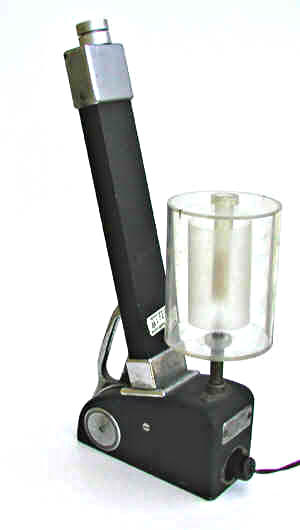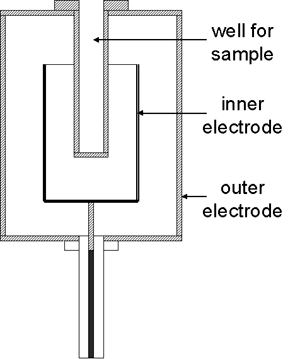Well-type Condenser Ionization Chamber

The photograph to the right shows a well-type condenser ion chamber built by Carl Braestrup (ca. 1940s). The chamber is shown connected to a string electrometer (more information about the electrometer).
This well-type (reentrant) chamber provides close to a four pi counting geometry since the sample is effectively positioned inside the chamber at its physical center. The sample, usually a liquid in a test tube, is counted inside a well-like depression at the top of the chamber wall (outer electrode).
Prior to the introduction of the sample, the chamber would be charged so that a potential was created between the inner and outer electrode. This was accomplished with a string electrometer of the type seen in the photograph. When the sample was placed inside the well, the emitted radiation ionized the air in the chamber and reduced the charge. A measurement was then performed of the time it took the electroscope fiber to move a specific number of divisions. Using a calibration that was appropriate for the radionuclide being measured, this time was related to the sample activity.
As seen in the diagram to the left, a sample positioned in the well is also inside the tubular inner (central) electrode.

The plastic example in the photograph is probably a model that Braestrup used to illustrate the construction details. Feitelberg (1949) described the Braestrup well chamber as being constructed from brass.
Donated by Richard Mooney.
References
- A similar diagram of a chamber of this design, attributed to Braestrup, can be seen in NBS Handbook 80 (NCRP Report No. 28), “A Manual of Radioactivity Procedures.”
- Feitelberg, S. "Standardization of Radioactive Iodine" Science May 6, 1949, p. 456.
Carl B. Braestrup (1897-1982) was born in Copenhagen Denmark. He worked as an engineer at Bell Telephone Laboratories and Picker X-ray Corporation, instructed at the Post Graduate Medical School of Columbia University, and served as the Director of the Physics Laboratory of the New York City Department of Hospitals. He was one of the first in the 1930’s to develop a film badge that would account for the energy of the radiation and was one of the first ten persons certified in X-ray physics by the Radiological Society of North America. An internationally recognized expert on shielding design, he developed a standardized approach to the shielding design for medical and industrial X-ray facilities that formed the basis of the NCRP 49 methodology. Together with Harold Wyckoff, he coauthored the classic textbook Radiation Protection (1958).
